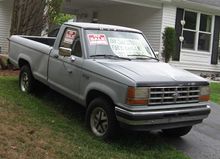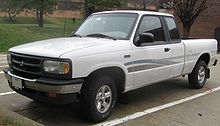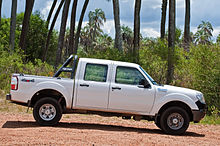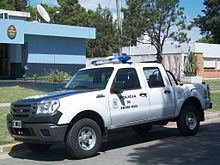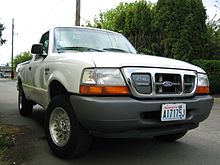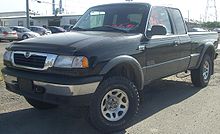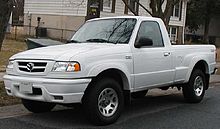- Ford Ranger (North America)
-
This article is about the North American car model. For models sold internationally, see Ford Ranger.
Ford Ranger (North American) 
Manufacturer Ford Motor Company Model years 1983–2011 Assembly St. Paul, Minnesota, United States
Edison, New Jersey, United States
Louisville, Kentucky, United StatesPredecessor Ford Courier Class Compact pickup truck Layout Front-engine, rear- / four-wheel drive The Ford Ranger is a pickup truck produced by the Ford Motor Company. The "Ranger" name had previously been used for a premium styling package on the F-Series full-sized pickup trucks since 1965. The name was moved to this line of North American compact trucks for the 1983 model year.
In North America, the Ranger is Ford's compact pickup truck. The Ranger replaced the Ford Courier, an American version of the Mazda B-Series, in a segment largely defined by the Toyota and Datsun pickup trucks. The Ranger was the best-selling compact pickup in America from 1987 to 2004.
The Ranger and related Mazda B-Series are manufactured at Ford's Twin Cities Assembly Plant in St. Paul, Minnesota, which is now scheduled to close in 2011. They were also assembled in Louisville, Kentucky until 1999 and in Edison, New Jersey until the plant's closing in 2004. Second generation models were also sold as the Mazda B-Series. Mazda has used the engine displacement to determine the name. Thus, the B2500 had a 2.5 L I4 engine, and the B4000 has a 4.0 L V6. For 2002, the name was changed to simply Mazda Truck in the United States. Mazda's partnership with Ford has resulted in the sharing of this vehicle—the Mazda B-Series and Ford Ranger are essentially the same after 1994.
Contents
First generation
First generation 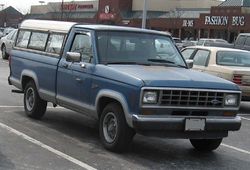
Production January 1982–1992 Engine V6 enginesDiesel engines- 1983-1984: 2.2 L Perkins 4.135 Diesel I4
- 1985-1986: 2.3 L Mitsubishi 4D55 Turbodiesel I4
Transmission Manual transmissions- 4-speed Toyo Kogyo TK4
- 5-speed Toyo Kogyo TK5
- 5-speed Mitsubishi FM132
- 5-speed Mitsubishi FM145
- 5-speed Mitsubishi FM146
- 5-speed Mazda M5OD-R1
Automatic transmissions- 3-speed C3
- 3-speed C5
- 4-speed A4LD
Wheelbase 107.9 in (2,741 mm)
113.9 in (2,893 mm)
125 in (3,175.0 mm)Length Standard bed
1983-1988:175.6 in (4,460 mm)
1989-1992:176.5 in (4,483 mm)
SuperCab
1983-1988:187.6 in (4,765 mm)
1989-1992:188.5 in (4,788 mm)
Long bed
1983-1988:192.7 in (4,895 mm)
1989-1992:193.6 in (4,917 mm)Width 1983-1988: 66.9 in (1,699 mm)
1989-1992: 66.8 in (1,697 mm)Related Ford Bronco II
Ford Explorer
Mazda Navajo1983–1988
Ford began development of the Ranger in 1976, focusing on quality and fuel efficiency. The intent was to build a truck that was as capable as the full-size F-Series, but in a more economical package. The compact Ranger had a similar styling to the full-size Ford F-Series, used a similar architecture, and was offered with a four-wheel drive capability. This ability allowed the Ford Ranger to haul a four-foot-wide (1.2 m) sheet of plywood, which is a common standard for a pickup truck. In the compact Ranger, however, the space between the wheel wells was less than four feet; Ford designed the box with provisions to allow hauling of a standard sheet of plywood.[1]
1983 Ranger production began January 18, 1982 at the Louisville Assembly Plant,[2] hitting showrooms in March.[3] Available engines were the 72 hp (54 kW) 2.0 L and 86 hp (64 kW) 2.3 L OHC four-cylinders, a four-cylinder 59 hp (44 kW) 2.2 L Mazda/Perkins diesel, and a 115 hp (86 kW) 2.8 L Cologne V6. In 1985, a Mitsubishi-built 2.3 L turbodiesel with 86 hp (64 kW) replaced the Mazda diesel engine, and in 1986, the 2.8 L engine was replaced with a 140 hp (104 kW) 2.9 L Cologne V6. The Super-cab was introduced in 1986, offering an extra 17 inches (432 mm) of storage space behind the front seats, with a pair of jump seats available as an option. A lot of the parts of the interior such as the steering wheel and the window cranks were similar to those in other Ford vehicles like the Bronco, Escort, and the F-Series.
Mid-year 1986 saw the introduction of the Ranger GT. Available only as a standard cab with a short bed, it had a 2.9 L Cologne V6 with either a 5-speed Toyo Kogyo manual transmission or an optional A4LD automatic transmission putting power to a Traction-Lok differential with a 3.73 gear ratio. Inside, the pickup was equipped with special bucket seats, full instrument cluster, and an optional center console. Front and rear sway bars were installed, and 14x6 aluminum wheels completed the package. A long bed option was added for 1987, and a new ground effects package was introduced in 1988.[4]
1989–1992
The truck received a facelift for 1989, which included flush composite headlamps, new front fenders, hood, and grille, along with some upgrades to the frame. Inside, there was a modern new dashboard and steering column.
The new steering column included, on automatic transmission-equipped models, a column-mounted gear shift, and key removal on manual transmission models became a simpler, one-handed operation. Manual-equipped 1983–88 models had the key release button beneath the column on the left-hand side, requiring drivers to use both hands to remove the key.
Rear-wheel antilock brakes were added, and a 21 US gal (79 L; 17 imp gal) fuel tank was now optional on extended-cab models.
The 2.0 L engine was discontinued, and the 2.3 L now had a distributorless ignition system with two spark plugs per cylinder, giving it a 14 hp (10 kW) boost and better fuel economy.[5] The three-speed automatics were dropped, leaving only the A4LD. The new 160 hp (119 kW) 4.0 L Cologne V6 was added to the option list for all models in 1990. The 145 hp (108 kW) 3.0 L Vulcan V6 was introduced to replace the 2.9 L Cologne in rear-wheel drive trucks later in 1990. With the new engines, the only manual transmission available was the 5-speed M5OD-R1.
The Ranger GT was discontinued, although the Ford Truck Public Affairs office did build a prototype for 1990 powered by a 3.0 L SHO V6.[6][7]
Second generation
1993–1997
1993–1997 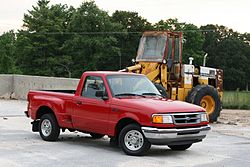
Production 1993–1997 Assembly Argentina: General Pacheco
United States: St. Paul, Minnesota; Edison, New JerseyBody style 2-door compact
2-door extendedEngine 2.3 L OHC I4
3.0 L Vulcan V6
4.0 L Cologne V6Transmission Manual
5-speed Mazda M5OD-R1
Automatic
4-speed A4LD
4-speed 4R44E
4-speed 4R55E
5-speed 5R55EWheelbase 107.9 in (2,741 mm)
113.9 in (2,893 mm)
125.2 in (3,180 mm)Length 184.3 in (4,681 mm)
196.3 in (4,986 mm)
198.2 in (5,034 mm)Width 69.4 in (1,763 mm) Related Ford Explorer
Mazda Navajo
Mercury MountaineerIn 1993 there was another redesign, with a shape more aerodynamic than before. Overall the truck had smoother lines, and other changes included flush-mounted door glass, wider doors, and slight fender flares. The 1989-style dashboard remained, but the seats and door panels were new. The 2.9-liter engine was discontinued. The engines offered were offered in displacements of 2.3-, 3.0- and a 4.0 liters. The Mazda M5OD-R1 was now the sole manual transmission option. A new "Splash" model was introduced, which had a flare side bed, unique chrome wheels, 1 inch (25 mm) lowered rear suspension and a 2 inch lowered front suspension (on 4x2 models), and special vinyl "Splash" decals on the sides and the tailgate. The 1993 Splash models were only available as a regular cab, and were offered in arctic white, gloss black, red orange, and sky blue. The Mazda B-Series became a rebadged Ranger for the 1994 model year, but the Mazda B-Series did not offer an equivalent to the Splash model. For the 1994 model year, the Splash trim had options which all included; a 1 in (25 mm) lowered rear suspension and 2 inch lowered front suspension (on 4x2 models), flare side bed, an extended cab, and unique chrome wheels. The decals also underwent subtle changes. While the 1993 – 1994 models donned red, yellow and blue stripes, the 1995 – 1996 models had lime green stripes with more emphasis on the "scatter" design. Additionally, the available colors for the Splash model changed from the 1993 – 1994 models to the 1995 – 1997 models. The latter were offered in Maroon Red, Gloss black, White, and Canary Yellow. The Splash model was the first Ranger to offer power mirrors, and throughout the 3rd generation's production run, power mirrors remained exclusive to the Splash models. For the 1997 and final model of the Splash, only the name "Splash" was used, without the stripes.
A number of changes were made for 1995. The steering wheel was modified to include a driver's side airbag and the dashboard was completely redesigned in a similar way to the new-for-1995 Explorer, except that the passenger air bag was optional and not available until 1996. The A4LD transmission was updated. 2.3 L and 3.0 L models got the 4R44E, while 4.0 L trucks got the 4R55E. The front brakes were changed to use the same 2-piston brake calipers as the second generation Explorer, and four-wheel anti-lock brakes were added as standard on 4x4 and 4.0 L models.
South America
In 1995 Ford started importing the two-door Ranger SuperCab from the US to South America with the 4.0-liter Cologne V6 gasoline engine. As demand increased, Ford decided to build it locally in Buenos Aires Argentina at the Ford General Pacheco Assembly Plant for the Argentinian, Chilean, Brazilian,[8] Peruvian,[9] and Mexican markets. Ford started local production in 1996 with a single cab, gasoline engine version, but by November 1997 the supply is increased with diesel and gasoline engines, two-wheel, four-wheel drive and different levels of equipment.
Mazda B-Series
The North American 1994 Proceed/B-Series was new, the design having been merged with the Ford Ranger.Mazda continued to manufacture its own trucks in Japan and elsewhere, but for the North American market, the design was shared, as were the engines.The new B3000 and B4000 boasted large Ford V6 engines, and the M5OD-R1 manual transmission returning to the options sheet.Extended cab models were available, as was all wheel drive, and two trim lines, LE and SE.The 3.0 L B3000 was dropped for 1997, and the entire line was refreshed after that year.
Engine options:
- B2300
- B3000
- B4000
- 1994–1997 – 4.0 L (4016 cc) Cologne V6, 160 hp (119 kW)
1998–2011
1998–2011 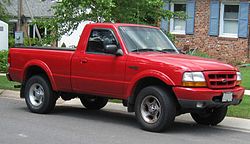
Also called Mazda B-Series Production 1998–2011 Assembly Argentina: General Pacheco
United States: St. Paul, Minnesota; Edison, New JerseyBody style 2-door compact
2-door extended (1998)
2+2-door extended (1999-2011)
4-door crew cab (South America)Engine 2.3 L Duratec I4
2.5 L OHC I4
3.0 L Vulcan V6 (1998–08)
4.0 L Cologne V6
4.0 L 4.0 SOHC V6Transmission Manual
5-speed Mazda M5OD-R1
Automatic
4-speed 4R44E
5-speed 5R55EWheelbase 111.6 in (2,835 mm)
117.6 in (2,987 mm)
125.9 in (3,198 mm)Length 188.5 in (4,788 mm)
200.5 in (5,093 mm)
202.9 in (5,154 mm)Width 70.3 in (1,786 mm) Height 68.3 in (1,735 mm)
69.4 in (1,763 mm)Related Ford Explorer
Mercury MountaineerIn 1998 the Ranger got another redesign, giving it a longer wheelbase and a three-inch (76 mm) longer cab for the regular cab models (part of which provided more room in the interior. The 1995–97 interior look was retained. The twin I-beam front suspension was replaced by the wishbone-style system found on the Explorer and the front half of the frame was of "boxed", rather than C-channel construction. Rack and pinion steering was also added. Also, for the 2000 model year, amber rear turn signals were discontinued. The four-cylinder engine was bumped up to a 2.5 L SOHC I4 giving it a 6% increase in power over the old 2.3 L. It put out 120 hp (89 kW) and 149 lb·ft (202 N·m) of torque. That engine was replaced by a new DOHC 2.3 L Duratec I4 in mid-2001. 2001 also saw the pushrod 4.0 L V6 replaced by the SOHC version from the Explorer, bringing with it a beefier M5OD-R1HD manual transmission. Also in 2001, the five-speed automatic transmission that was introduced in 1997 for the 4.0 V6, was now also available with the 2.3 I4 and 3.0 V6. The Ranger received a facelift, including a new grille, hood, and front bumper, as well as updated headlights and taillights. SLP produced a version of the Ranger called "thunderbolt". This model included different options such as a unique front and rear bumper, air intake, exhaust and even a spoiler. In 2004 the Ranger received minor updates to the grille, hood, and front bumper. New front bucket seats were also added in 2004 to meet the new U.S. Federal safety requirements. In 2006 the Ranger received more minor updates to the grille, front turn signals and taillights, along with a bigger rear Ford logo that was now centered in the middle of the tailgate.
The current Ranger is offered with a 143 hp (107 kW) 2.3-liter I4 and a 207 hp (154 kW) 4.0-liter V6. The 3.0 Vulcan V6 was discontinued as of the 2009 model year. The FX4 Level II version comes with a special 31-spline 8.8-inch (223.5 mm) rear axle equipped with a Zexel-Torsen limited-slip differential, three skid plates, upgraded tow hooks, 31" BFGoodrich All Terrains, 15-inch Alcoa wheels, and Bilstein shocks. Inside, the Level II package added leather front bucket seats and rubber floors along with a six-CD MP3 headunit as standard options. The truck uses code R1 (for two-door) and R4 (for four-door) in the 5th and 6th positions of the VIN.
In December 2009, Ford announced that specialty-designed custom graphics would be applied to the Ranger beginning with the 2010 models. The feature will be exclusive to Ford Dealers and will allow customers to pick a design that they want customized for their Ranger trims.[10]
As of 2010 in the US, the Ranger is no longer offered with the FX4 trim level. The FX4 is still available in Canada; however, it is a $2500 option on top of the Sport trim level. The FX4 package cannot be applied to an XLT. The FX4 for the 2010–2011 model years in Canada come with a 4.10 limited slip rear end.
For the 2011 model year, the level trims have adjusted. The XL trim will be the standard level, followed by the XLT and Sport trims. The latter two will include Sirius radio as a optional feature.[11]
The Ford Ranger was the first small pickup to introduce dual air bags as safety features.[citation needed] It received an "acceptable" frontal crash test rating from the Insurance Institute for Highway Safety when they were first tested in 1998, while many of its competitors received "marginal" or "poor" ratings at that time. The exception was the Toyota Tacoma, which also got an "acceptable" rating.[12][13]
The 2010 model year brought the addition of front seat combination head and torso airbags to improve passenger safety in a side-impact collision and earned Good rating through the Insurance Institute for Highway Safety's Side Impact Test. Also Electronic Stability Control was added for the 2010 Models as Standard Equipment.[14]
In the Roof Strength Test conducted by Insurance Institute for Highway Safety, the Ford Ranger earned an Acceptable rating.[15]
South American production
After two years of local production in Argentina, Ford introduced the same version of the newly updated 1998 Ranger. Along with the single cab (the North American SuperCab), South America received an exclusive double cab body variant.[16] The crew cab was not sold in North America, as it was essentially identical to the Ford Explorer Sport Trac undergoing development.
There was a choice of two powerplant options including a 3.0-liter PowerStroke turbocharged four-cylinder diesel with 163 horsepower and 280 lb-ft of torque mated to a Eaton FSO-2405-A five-speed manual transmission.
In 2007 Ford invested US$156.5 million in its facility in General Pacheco, Argentina.[17] For 2008, the Ranger received a makeover with a grill and headlights similar to the 2006 North American version; bed extenders became available for all boxes.[18] The 2010 Ranger was updated further with new sheet metal giving it a more aggressive stance; it also received its own version of the corporate three-bar grille completely different from its North American counterpart. Other changes included redesigned outer door skins with pull-out door handles and wider wheel arches, though the 2008 interior was retained as well as the two engine choices.
In 2010 Ford also introduced a new optional engine to run exclusively on compressed natural gas, which makes it the first pick up of Argentina to offer a factory-built natural gas vehicle (NGV) commercially available in Argentina.[19][20]
Outside of Argentina, the Ranger was sold as a badge-engineered version of the Mazda B-Series (to 2006) and the BT-50 (2006-2011); these was assembled in Colombia and Ecuador (in CKD form). As the North American Ranger became the basis of the first generation Explorer, the Mazda-based Ranger is the basis of a body-on-frame SUV named the Ford Everest sold in markets outside of North America and Europe.
After 2011, the Ranger T6 designed by Ford of Australia will replace both the North American and Mazda-based versions; it will be produced in Argentina.
2010 Ford Ranger (Argentina) Wheelbases and bed lengths[21]:
- 2010–present – 111.5 inches (2,831 mm) – 6 ft. bed (1,732mm) Single Cab
- 2010–present – 117.6 inches (2,987 mm) – 7 ft. bed (2,129mm) Single Cab
- 2010–present – 125.7 inches (3,192 mm) – 5 ft. bed (1,467mm) Double Cab
Engines[21]:
Engine Years Power Torque 2.3 L Duratec HE Gasoline I4 2004–2011 148 hp (110 kW) 159 lb·ft (216 N·m) 3.0 L Power Stroke Diesel I4 2004–2011 163 hp (122 kW) 280 lb·ft (380 N·m) Electric Ranger
Main article: Ford Ranger EVThe Ford Ranger EV was a battery electric vehicle produced by Ford Motor Company; it was produced from 1998 to 2002. The chassis of the four-wheel drive model was used, but the Ranger EV was strictly a rear-wheel drive vehicle. Unlike other versions, the EV was designed with an independent rear suspension (with de Dion tube). 1998 models employed lead-acid batteries while subsequent models used Nickel metal hydride (NiMH) batteries.
The Ranger EV is largely indistinguishable from a standard Ranger except for its grille. On EV models, a door for a charging port is located on the right third of the grille.
Mazda B-Series
North America saw a redesigned B-Series again for 1998, with a larger base engine. A five-speed automatic transmission was available.The 1999 B-Series added four doors, a first in the extended-cab pickup truck market. In 2001 a more powerful SOHC version of the 4.0 L V6 replaced the old OHV engine, while Ford's Duratec engine replaced the ancient Lima engine in four-cylinder models the following year. 2007 was the last year for 3.0 L B-Series trucks. For 2009, the B4000 Cab Plus SE model was discontinued in the United States market. The full B-Series lineup was discontinued, in the United States, at the end of the 2009 model year, while the Ford Ranger remains in production.[22] The B-Series was sold in the Canadian market for one more model year.Engine options:
- B2500
- B2300
- B3000
- B4000
Discontinuation in North America
It was reported in 2005 that an all-new Ranger, codenamed P273, was in the works to be introduced by 2010.[23] The P273 was slated to be world pickup, presumably to be merged with the Mazda world pickups. A 2007 Ranger for the Thai market based on the Asian 4Trac concept was unveiled, but it is not scheduled to replace the North American truck. According to a recent article in the Car and Driver, there are three alternatives for Ford: 1) to redesign and continue to build the next generation in North America; 2) to import the new Ford Australian developed midsize 35+ mpg diesel version ute from the plant in Thailand;[24] and 3) to discontinue the Ranger line and exit the compact pickup market in North America.[25] There are rumors that Ford's future product plans in the compact pickup market segment will be announced closer to the end of Ford Ranger production at the St. Paul, Minnesota plant in 2010–2011. There are reports that the plant will be sold and redeveloped once the production is ceased.[26][27]
Ford chose to invest improvements in the Ford Explorer SUV which was branched to a more advanced platform than the Ranger, letting Ranger's sales decline. However as a result of the shift toward smaller and more fuel efficient vehicles in North America, Ford has said it will continue to produce the current Ford Ranger through 2012 at its Twin Cities, Minn. plant, which was previously scheduled to close in 2009.[28]
This production extension has led to speculation that the next generation Asean Ranger, codenamed T6, already at an advanced stage of development by Ford Australia,[29] would be sold in North America despite being designed for global markets outside of North America. The T6 Ranger entered production in 2011.
As of May 2010, T6 engineering prototypes are being tested in various countries including the U.S.[30] It is expected that the new truck will come with at least two engine choices: a 2.0 L EcoBoost four-cylinder, and the 3.0 L Duratorq diesel for models sold outside the U.S.[30]
In recent years, Ranger's competitors, from the Nissan Frontier to the Toyota Tacoma have been redesigned and enlarged towards the mid-size market, leaving the Ranger the only truck in the US compact market segment. The Ranger remains a decent seller for Ford,[31] with companies like Auto Zone buying them regularly as well as those individuals seeking good fuel mileage in a compact truck (Ranger gets better MPG than any other pickup with its Mazda-derived 4cyl engine).
Ford initially considered a smaller-than-F-150 pickup truck, one based on the F-Series (following the older F-100 offering). This proposal was cancelled in favor of offering an EcoBoost engine in the F-150 product line.[32]
Ford has confirmed that they will end production on the Ranger in 2011, and have no plans to offer the next generation in the United States, which means that the T6 version will only be available outside the US. The decision as to why the Ranger will no longer be available in the United Staes is that the new global platform is simply too close in size to the F-150. Another factor is due to declining sales, as Ford's Vice President of Global Product Development, Derrick Kuzak, notes that the compact pickup market in the United States has been declining for the past 15 years, dropping from eight percent of the industry in 1994 to around two percent in 2010. The ending of the Ranger in the United States also marks a departure for Ford from the compact truck segment after 30 years.[33]
On June 22, 2011, a report from the United Auto Workers 879, which represents workers at the factory where the North American Ranger is produced, was released which stated that production of the Ranger was planned to end on December 19, 2011.[34]
Yearly American sales
Calendar Year Total American sales 1999[35] 348,358 2000 330,125 2001[36] 272,460 2002[37] 226,094 2003 209,117 2004[38] 156,322 2005 120,958 2006[39] 92,420 2007 72,711 2008[40] 65,872 2009[41] 55,600 2010[42] 55,364 See also
- Ford Ranger (South America)
References
- ^ Clark, Jim (December 1981). "Development of the Ranger" (PDF). Mini-Truck: 26–31. http://www.therangerstation.com/resources/pdf_documents/ranger.pdf.
- ^ Stark, Harry A, ed (1983). Ward's Automotive Yearbook 1983. Ward's Communications, Inc. p. 69.
- ^ Stark, Harry A, ed (1982). Ward's Automotive Yearbook 1982. Ward's Communications, Inc. p. 22.
- ^ "Ranger GT History". The Ranger Station. http://www.therangerstation.com/resources/RangerGT_History.html. Retrieved 2008-04-26.
- ^ "1988 MPG ratings". http://www.fueleconomy.gov/feg/bymodel/1988_Ford_Ranger_Pickup.shtml. Retrieved 8 November 2011.
- ^ Hamilton, Frank. "SHO Down. Have you stomped in a Ford lately?". Minitruckin' (Spring 1990): 28–31.
- ^ "SHO Ranger article copy". http://rockledge.home.comcast.net/~rockledge/RangerPictureGallery/SHO/SHORanger.pdf. Retrieved 2010-08-08.
- ^ Ford Ranger- Accessed 03/11/2011
- ^ Ford Ranger Peru (in Spanish) - Accessed 03/11/2011
- ^ "Fancy a camouflage F-150? Graphics for entire Ford lineup coming soon" from Autoblog.com (December 18, 2009)
- ^ 2011 Ford Ranger from media.ford.com (July 2010)
- ^ "IIHS-HLDI: Ford Ranger regular cab". Iihs.org. 2009-11-18. http://www.iihs.org/ratings/rating.aspx?id=97. Retrieved 2010-03-23.
- ^ "IIHS-HLDI: Small pickups – Earlier Models". Iihs.org. http://www.iihs.org/ratings/earliermodels.aspx?class=75. Retrieved 2010-03-23.
- ^ "IIHS-HLDI: Ford Ranger extended cab". Iihs.org. 2010-02-04. http://www.iihs.org/ratings/rating.aspx?id=1236. Retrieved 2010-03-23.
- ^ "Roof strength evaluations: Small pickups". Iihs.org. http://www.iihs.org/ratings/roof/detailsbyclass.aspx?75. Retrieved 2010-03-23.
- ^ Ford Pick up history in Argentina (in Spanish) - Accessed 03/11/2011
- ^ Ford to invest US$156.5m in Pacheco facility- Accessed 03/08/2011
- ^ Ranger 2008 (in Spanish) - Accessed 03/08/2011
- ^ presentó la nueva Ford Ranger 2010 (in Spanish) - Accessed 03/08/2011
- ^ Ford Ranger 2010 (Mercosur), primeras imágenes y datos (in Spanish) - Accessed 03/10/2011
- ^ a b Owner's manual (in Spanish) - Accessed 03/08/2011
- ^ Bengt Halvorson (2009-09-21). "B-Series, B-Seeing You: Mazda Leaves U.S. Pickup Market". The Car Connection. http://blogs.thecarconnection.com/marty-blog/1035480_b-series-b-seeing-you-mazda-leaves-u-s-pickup-market. Retrieved 2009-10-09.
- ^ "Future Cars: Ford/PAG/Mazda". The CarConnection.com. March 30, 2005. http://www.thecarconnection.com/Shoppers/Future_Cars/Ford.S283.A8367.html.
- ^ www.youtube.com 2012 Ford Ranger - Accessed 03/08/2011
- ^ Priddle, Alisa (July 2007). "Ford Ranger Endangered?". Car and Driver. http://www.caranddriver.com/carnews/13303/ford-ranger-endangered.html.
- ^ Estrada, Herón Márquez (May 8, 2007). "Ford says it's close to selling hydroelectric plant in St. Paul". http://www.startribune.com/business/11217036.html. Retrieved 2008-04-26.
- ^ Meersman, Tom (September 1, 2007). "Is game over for Ford plant's ball fields?". http://www.startribune.com/local/11588716.html. Retrieved 2008-04-26.
- ^ "Ford accelerates transformation plan with small car offensive, manufacturing realignment". Ford Fleet. July 24, 2008. http://media.ford.com/article_display.cfm?article_id=28660.
- ^ "No foundation to T6 rumours". Carsales.com.au. August 13, 2008. http://www.carsales.com.au/car-review/2970052.aspx.
- ^ a b Johnson, Drew (May 18, 2009). "2012 Ford Ranger Spied again". Left Lane News. Leftlane. http://www.leftlanenews.com/ford-ranger-2012.html. Retrieved 2009-07-30.
- ^ "NEWS" (PDF). http://media.ford.com/images/10031/September09sales.pdf. Retrieved 2010-03-23.
- ^ "Ford tables plans for F-100 pickup". Edmunds Inside Line. Edmunds, Inc. August 8, 2008. http://blogs.edmunds.com/straightline/2008/08/ford-tables-plans-for-f-100-pickup.html.
- ^ Bowman, Zach (September 20, 2010). "U.S.-spec Ford Ranger to officially end production in 2011, Ford explains why". Autoblog. http://www.autoblog.com/2010/09/20/u-s-spec-ford-ranger-to-officially-end-production-in-2011-ford. Retrieved October 9, 2010.
- ^ "Report: For St. Paul Ford plant, end of line is Dec. 19". Autoblog. June 22, 2011. Archived from the original on June 22, 2011. http://www.webcitation.org/5ze1xO3Qg. Retrieved June 23, 2011.
- ^ "Ford Motor Company Sets New Full Year U.S. Sales Record". Theautochannel.com. http://www.theautochannel.com/news/press/date/20010103/press033466.html. Retrieved 2009-04-28.
- ^ "Ford Motor Company's December U.S. Sales Climb 8.2 Percent". Ford Motor Company. http://media.ford.com/pdf/Dec2002sales.pdf.
- ^ "Ford's F-Series Truck Caps 22nd Year in a Row as America's Best-Selling Vehicle With a December Sales Record". Theautochannel.com. 2004-11-17. http://www.theautochannel.com/news/2004/01/05/175829.html. Retrieved 2009-04-28.
- ^ "Ford Achieves First Car Sales Increase Since 1999". Theautochannel.com. 2004-11-17. http://www.theautochannel.com/news/2006/01/04/204860.html. Retrieved 2009-04-28.
- ^ "Ford Motor Company 2007 sales". January 3, 2008. http://media.ford.com/article_download.cfm?article_id=27379.
- ^ "F-Series drives ford to higher market share for third consecutive month". Ford Motor Company. January 5, 2009. http://media.ford.com/images/10031/dec08sales.pdf. Retrieved 2009-05-14.
- ^ "FORD CAPS 2009 WITH 33 PERCENT SALES INCREASE, FIRST FULL-YEAR MARKET SHARE GAIN SINCE 1995". Ford Motor Company. January 5, 2010. http://media.ford.com/images/10031/December09sales.pdf. Retrieved 2010-01-05.
- ^ "FORD’S 2010 SALES UP 19 PERCENT – LARGEST INCREASE OF ANY FULL-LINE AUTOMAKER; FOUNDATION SET FOR GROWTH IN 2011". Ford Motor Company. January 4, 2011. http://media.ford.com/images/10031/Dec10sales.pdf. Retrieved 2011-01-05.
External links
Recent, current, and future vehicles, North American market from Ford Motor Company Passenger cars Crossover vehicles Sport Utility Vehicles Trucks/Vans Recently discontinued models
(2000s-early 2010s)Crown Victoria/Police Interceptor · Escort/ZX2 · Excursion · Explorer Sport Trac · Five Hundred · Freestar · Freestyle/Taurus X · GT · Ranger/Ranger EV · Thunderbird · WindstarType 1980s 1990s 2000s 2010s 0 1 2 3 4 5 6 7 8 9 0 1 2 3 4 5 6 7 8 9 0 1 2 3 4 5 6 7 8 9 0 1 2 Mid-size crossover Edge Full-size crossover Freestyle Taurus X Flex Compact SUV Bronco II Bronco II Escape Escape Mid-size SUV Explorer Explorer Explorer Explorer Explorer Full-size SUV Bronco Bronco Bronco Expedition Expedition Expedition Excursion Expedition EL/Max Compact pickup Courier Ranger Ranger Ranger Ranger Mid-size pickup Explorer Sport Trac Explorer Sport Trac Full-size pickup F-Series F-Series F-Series F-Series F-Series F-Series Super Duty Super Duty Minivan Aerostar Aerostar Transit Connect Windstar Windstar Freestar Van Econoline Econoline/E-Series Categories:- Flexible-fuel vehicles
- Ford vehicles
- Pickup trucks
- All wheel drive vehicles
- Rear wheel drive vehicles
- 1980s automobiles
- 1990s automobiles
- 2000s automobiles
- 2010s automobiles
- Vehicles introduced in 1983
- Motor vehicles manufactured in the United States
Wikimedia Foundation. 2010.

